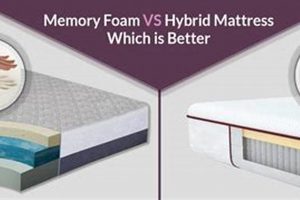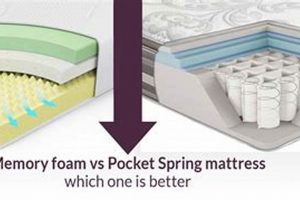Specialized support surfaces are frequently used in healthcare settings to prevent and manage pressure injuries. Two common types of these surfaces utilize air inflation technology. One system provides continuous airflow to reduce moisture and pressure. The other cyclically redistributes pressure by inflating and deflating different air cells. These different mechanisms aim to achieve similar goals: minimizing pressure concentration and promoting tissue perfusion.
The selection of an appropriate support surface is crucial for patient care, impacting both comfort and clinical outcomes. Utilizing specialized surfaces can significantly reduce the incidence of pressure ulcers, leading to improved patient well-being and reduced healthcare costs. Historically, static mattresses were the standard, but the advent of dynamic air systems has revolutionized pressure injury prevention protocols, particularly for high-risk individuals.
This discussion will examine the characteristics, functionalities, and appropriate applications of these two distinct air mattress technologies, providing a comprehensive comparison for informed decision-making in clinical practice. A detailed exploration of each systems strengths and limitations will assist clinicians in selecting the optimal support surface based on individual patient needs and risk factors.
Considerations for Air Mattress Selection
Selecting the appropriate support surface involves careful evaluation of patient needs and mattress characteristics.
Tip 1: Assess Patient Risk: Utilize validated risk assessment tools (e.g., Braden Scale) to determine the patient’s susceptibility to pressure injuries. Higher risk scores often necessitate more aggressive pressure redistribution strategies.
Tip 2: Evaluate Moisture Management Needs: Consider the patient’s incontinence status and perspiration levels. Increased moisture can exacerbate pressure injury risk, making surfaces with enhanced moisture-wicking properties crucial.
Tip 3: Examine Patient Mobility: Assess the patient’s ability to reposition independently. Patients with limited mobility benefit significantly from active pressure redistribution features.
Tip 4: Evaluate Weight Capacity: Ensure the chosen support surface’s weight capacity aligns with the patient’s weight to maintain optimal function and prevent damage to the mattress.
Tip 5: Monitor Skin Integrity: Regularly assess the patient’s skin for signs of pressure injuries. Early detection allows for timely adjustments to the support surface and care plan.
Tip 6: Consider Microclimate Control: For patients prone to excessive sweating, a system with microclimate control features may improve comfort and reduce skin maceration.
Tip 7: Assess Patient Comfort: While therapeutic benefits are paramount, patient comfort should also be considered. A surface that adequately redistributes pressure while minimizing discomfort promotes compliance and overall well-being.
Prioritizing individualized patient assessments and matching surface characteristics to specific needs leads to improved patient outcomes and reduced incidence of pressure injuries.
The subsequent sections will delve deeper into the specific features and practical applications of each air mattress system in various clinical scenarios.
1. Pressure Redistribution
Effective pressure redistribution is the cornerstone of preventing and managing pressure injuries. In the context of specialized support surfaces, such as air mattresses, it dictates how effectively the mattress minimizes concentrated pressure on bony prominences, thereby promoting tissue perfusion and reducing the risk of ischemia and subsequent ulceration. Comparing air mattress systems highlights differing approaches to achieving this fundamental goal.
- Mechanism of Air Displacement
Alternating pressure mattresses actively shift pressure by cyclically inflating and deflating air cells. This periodic change ensures that no single area of the body experiences prolonged, uninterrupted pressure. In contrast, systems achieve pressure reduction through continuous airflow across the surface, minimizing pressure by distributing the patient’s weight over a larger area. The difference lies in how pressure is moved, one being active and the other passive-dynamic.
- Interface Pressure Reduction
Both modalities aim to lower interface pressure the force exerted between the patient’s skin and the support surface. Alternating pressure seeks to achieve this through pressure cycling, while mattresses focus on maintaining a consistently low pressure environment. Measurements of interface pressure can reveal the efficacy of each system in different patient populations, indicating the degree to which they actually alleviate pressure on vulnerable areas.
- Impact on Tissue Perfusion
The ultimate goal of pressure redistribution is to maintain adequate tissue perfusion. By minimizing prolonged compression of blood vessels, both systems promote blood flow to the skin and underlying tissues. However, their methods lead to varying effects on local circulation. Alternating pressure induces periods of increased and decreased blood flow, potentially challenging for patients with compromised vascular systems, while a low-air-loss maintains more constant flow.
- Clinical Applications and Patient Suitability
The choice between these systems for effective redistribution relies heavily on patient-specific factors. Alternating pressure may be more suitable for immobile patients at high risk of pressure injury, while the more stable support can be preferential for patients with certain spinal conditions. The ideal system selection considers the patients overall health, mobility level, and specific risk factors for pressure injury development.
In summary, both approaches strive for effective pressure redistribution, but they employ distinct mechanisms that render them suitable for different clinical scenarios. Understanding these nuances is essential for selecting the optimal support surface to minimize the risk of pressure injuries and improve patient outcomes.
2. Moisture Management
Elevated skin moisture significantly contributes to the development of pressure injuries. Prolonged exposure to moisture, whether from perspiration, incontinence, or wound exudate, weakens the skin’s integrity, increasing its susceptibility to friction and shear forces. Therefore, effective moisture management is a critical component of pressure injury prevention strategies, directly influencing the selection and utilization of specialized support surfaces.
These air mattress systems exhibit distinct capabilities in managing moisture at the skin-surface interface. Mattresses inherently possess enhanced moisture-wicking properties due to their continuous airflow. This airflow facilitates evaporation, reducing moisture accumulation and maintaining a drier microclimate. Examples include patients with hyperhidrosis, where a mattress may prove beneficial in reducing maceration. Conversely, alternating pressure mattresses primarily focus on pressure redistribution, and their moisture management capabilities are often secondary or dependent on additional features like specialized cover materials. In cases where incontinence is a significant concern, additional absorbent pads or moisture-barrier creams might be necessary, irrespective of the type of mattress used. The practical significance lies in understanding that while an airflow system can aid in moisture control, it may not be sufficient as a standalone solution for all patients, especially those with high levels of moisture exposure.
In summary, moisture management is a crucial consideration when choosing between these air mattress technologies. While low airflow systems provide inherent benefits in this regard, a comprehensive approach incorporating appropriate skin care protocols and supplementary measures is essential for effectively mitigating moisture-related pressure injury risks. Failure to adequately address moisture can undermine the effectiveness of even the most advanced pressure redistribution strategies, highlighting the interconnectedness of these factors in optimal patient care. Further research into advanced materials and designs that enhance both pressure redistribution and moisture management continues to be an area of ongoing innovation.
3. Airflow Regulation
Airflow regulation represents a fundamental distinction between support surface technologies designed to mitigate pressure injury risk. In the context of these two mattress systems, the method and degree of airflow control significantly impact their respective functionalities and suitability for diverse patient populations.
- Continuous Airflow vs. Cell Inflation Dynamics
systems are defined by a constant, regulated flow of air through perforations on the mattress surface. This airflow serves multiple purposes, including moisture management and temperature control, in addition to contributing to pressure redistribution. Alternating pressure mattresses, in contrast, regulate airflow primarily to inflate and deflate specific air cells in a cyclical pattern. The focus is on the differential pressure within the cells, rather than a consistent airflow across the entire surface. This difference in airflow management is pivotal in determining the systems’ respective strengths.
- Pressure Adjustment Capabilities
The precision with which airflow is regulated directly influences the adjustability of the support surface. Systems often allow for customization of airflow volume to accommodate varying patient weights and body mass distributions. This ensures optimal pressure redistribution tailored to individual needs. Alternating pressure mattresses adjust pressure by altering the inflation cycles and pressure levels within individual cells. While this provides dynamic pressure relief, it doesn’t offer the same level of granular control over continuous airflow as a mattress.
- Impact on Microclimate Control
Airflow regulation plays a key role in managing the microclimate at the skin-support surface interface. Controlled airflow helps to dissipate heat and moisture, reducing the risk of skin maceration and breakdown. This is particularly advantageous for patients prone to excessive sweating or incontinence. Alternating pressure systems, lacking continuous airflow, may not provide the same level of microclimate control unless specifically designed with moisture-wicking cover materials or integrated airflow features.
- Energy Consumption and Noise Levels
The method of airflow regulation affects the energy consumption and noise levels associated with each mattress system. Systems, requiring continuous operation of an air pump, may consume more energy compared to alternating pressure systems during periods of static inflation. Furthermore, the constant hum of the air pump can contribute to environmental noise, potentially impacting patient comfort and sleep quality. Consideration of these factors is relevant in long-term care settings and home healthcare environments.
The contrasting approaches to airflow regulation fundamentally shape the functionality and clinical application of systems and alternating pressure mattresses. Understanding these differences allows for informed decision-making, enabling healthcare providers to select the support surface best suited to individual patient needs and environmental considerations. A holistic approach considers all factors in reducing the risks of pressure injuries.
4. Cell Inflation Cycling
Cell inflation cycling is a defining characteristic differentiating alternating pressure mattresses from systems. Understanding its mechanisms and clinical implications is crucial for appropriate mattress selection.
- Mechanism of Pressure Modulation
Cell inflation cycling involves the sequential inflation and deflation of individual air cells within the mattress. This creates periodic pressure relief on specific areas of the patient’s body. The cycle duration and pressure levels within the cells are typically adjustable, allowing for customization based on patient needs. In contrast, systems maintain continuous inflation, lacking this cyclical pressure modulation.
- Impact on Tissue Perfusion and Ischemia
The cyclical pressure changes induced by cell inflation cycling aim to improve tissue perfusion by intermittently relieving pressure on capillaries. This can reduce the risk of prolonged ischemia and subsequent pressure injury development. However, the rapid inflation and deflation cycles may be contraindicated in patients with compromised cardiovascular function. Constant pressure from an airflow system, while not actively cycling, ensures consistent perfusion in conjunction with pressure redistribution.
- Clinical Indications and Contraindications
Alternating pressure mattresses with cell inflation cycling are often indicated for patients at high risk of pressure injuries, particularly those with limited mobility or impaired sensation. The cyclical pressure relief can be beneficial in preventing pressure-induced tissue damage. However, these systems may be contraindicated for patients with unstable spinal injuries or conditions where movement is detrimental. Airflow systems can often be used in these situations where the active inflation is contraindicated.
- Comparison to Continuous Pressure Redistribution
While cell inflation cycling provides active pressure relief, systems rely on continuous pressure redistribution through constant airflow and surface conformity. The choice between these approaches depends on the individual patient’s risk factors, clinical condition, and tolerance for movement. Patients who find the constant motion of alternating pressure mattresses disruptive may benefit more from the stable support provided by an airflow system. Additionally, airflow provides consistent moisture removal.
Cell inflation cycling, therefore, presents a distinct approach to pressure injury prevention compared to continuous pressure redistribution. Its suitability depends on careful assessment of patient-specific factors and clinical considerations. Further research comparing the effectiveness of these two approaches in various patient populations is warranted.
5. Shear Reduction
Shear forces, resulting from friction between the skin and a support surface, are a significant contributing factor to pressure injury development. These forces distort tissues, compromising blood flow and increasing the risk of ulceration, especially over bony prominences. Therefore, shear reduction is a critical consideration when evaluating support surfaces and comparing the functionalities of different air mattress systems.
- Surface Material and Friction Coefficient
The material composition of a mattress surface directly impacts its friction coefficient. Lower friction materials minimize the shear forces exerted on the skin during patient movement or repositioning. mattresses often utilize specialized fabrics with inherently low friction, while alternating pressure mattresses may rely on coatings or surface treatments to achieve similar results. The effectiveness of these materials can be quantified through standardized friction testing, providing an objective measure of their shear-reducing capabilities.
- Conformity and Immersion
A mattress’s ability to conform to the patient’s body contours and provide immersion contributes to shear reduction by distributing pressure more evenly. This minimizes the points of concentrated force where shear is most likely to occur. The continuous airflow and adjustability of a system allow it to adapt to the patient’s body shape, promoting optimal conformity. Alternating pressure mattresses, with their segmented air cells, may offer less consistent conformity, potentially increasing shear risk in certain positions.
- Mobility and Repositioning Assistance
Mattress systems that facilitate patient mobility and repositioning can indirectly reduce shear forces. By minimizing the effort required to move or adjust the patient’s position, these systems decrease the likelihood of dragging or sliding, which generates shear. Some airflow systems incorporate features like powered turning assists to further reduce the manual effort involved in patient handling. The effectiveness of these features should be evaluated in conjunction with established safe patient handling protocols.
- Microclimate Management and Moisture Reduction
As previously discussed, excessive moisture increases friction and exacerbates shear forces. Therefore, effective microclimate management is indirectly related to shear reduction. Systems, with their continuous airflow, promote moisture evaporation, maintaining a drier skin surface and reducing the risk of friction-related injury. Alternating pressure mattresses may require supplementary moisture-wicking measures to achieve comparable results.
In conclusion, shear reduction is a multifaceted consideration when comparing air mattress systems. Factors such as surface material, conformity, mobility assistance, and microclimate management all contribute to minimizing shear forces and protecting the patient’s skin integrity. Selection of the appropriate support surface requires careful evaluation of these factors, in conjunction with a comprehensive pressure injury prevention plan.
6. Patient Immobility
Patient immobility is a primary risk factor for pressure injury development, necessitating specialized support surfaces like air mattresses. The degree and nature of immobility directly influence the choice between a low air loss mattress and an alternating pressure mattress, each designed with distinct mechanisms to address the challenges posed by prolonged periods of reduced movement.
- Pressure Redistribution Needs
Immobile patients are unable to independently shift their weight, leading to sustained pressure on bony prominences. Alternating pressure mattresses, with their cyclical inflation and deflation, actively redistribute pressure, relieving it from vulnerable areas at regular intervals. Systems also redistribute pressure, but through a constant, low-pressure environment. The choice hinges on the severity of immobility; completely immobile patients may benefit more from the active redistribution of alternating pressure, while those with some limited movement may find a system adequate.
- Microclimate and Moisture Buildup
Immobility can exacerbate moisture accumulation due to reduced air circulation around the patient’s body. Low air loss mattresses excel at moisture management through continuous airflow, mitigating the risk of skin maceration. Alternating pressure mattresses typically lack this airflow feature, potentially requiring additional moisture-wicking strategies. Patients experiencing both immobility and incontinence are particularly susceptible and may benefit from a system’s enhanced moisture control.
- Risk of Shear and Friction
Immobile patients are at increased risk of shear and friction injuries during repositioning or transfers. Both systems and alternating pressure mattresses can incorporate features to minimize these forces, such as low-friction surface materials. However, the constant inflation of a mattress may provide a more stable surface for repositioning, potentially reducing shear risk compared to the dynamic surface of an alternating pressure mattress. The skill and technique of caregivers during repositioning remain paramount.
- Neurological Considerations
Specific neurological conditions contributing to immobility may influence mattress selection. Patients with spasticity or uncontrolled movements may find the cyclical pressure changes of an alternating pressure mattress stimulating or uncomfortable. In such cases, the consistent support surface of a system may be better tolerated. Conversely, patients with impaired sensation may benefit from the active pressure changes provided by an alternating pressure mattress, serving as a stimulus to prevent prolonged pressure on any single area.
In summary, patient immobility is a critical determinant in selecting the appropriate air mattress. The choice between systems and alternating pressure mattresses should be guided by a comprehensive assessment of the patient’s individual needs, considering pressure redistribution requirements, moisture management challenges, risk of shear forces, and underlying neurological conditions. A multidisciplinary approach, involving nurses, therapists, and physicians, is essential for optimizing patient outcomes.
7. Comfort Levels
Comfort levels represent a critical, yet often subjectively assessed, element in the selection of specialized support surfaces. While therapeutic efficacy in pressure injury prevention remains paramount, patient comfort directly influences compliance with prescribed care plans and overall well-being. In the context of systems and alternating pressure mattresses, comfort levels can vary significantly due to their differing mechanisms of action and inherent characteristics. An alternating pressure mattress’s cyclical inflation and deflation may be perceived as either therapeutic or disruptive, depending on the individual. The constant motion can be unsettling for some, leading to sleep disturbances and anxiety. Conversely, the dynamic pressure relief may be welcomed by others, particularly those experiencing significant pain or discomfort from prolonged immobility. In contrast, systems generally offer a more stable and consistent support surface. The continuous airflow and conforming nature may be perceived as more comfortable by patients who are sensitive to motion or prefer a firmer mattress. However, some individuals may find the constant airflow drying or cooling, requiring adjustments to room temperature or bedding.
The practical implications of comfort levels extend beyond mere patient satisfaction. Discomfort can lead to non-compliance with prescribed bed rest, increased agitation, and potentially, a higher risk of falls. For instance, a patient who repeatedly attempts to reposition due to discomfort on an alternating pressure mattress may inadvertently increase shear forces, negating some of the mattress’s pressure-redistributing benefits. Furthermore, sleep deprivation resulting from an uncomfortable mattress can impair wound healing and overall recovery. Therefore, a thorough assessment of patient preferences and sensitivities is crucial. This assessment should include not only a review of medical history and risk factors but also a direct dialogue with the patient to understand their individual comfort needs. Trials of different mattress types, when feasible, can provide valuable insights into which system is best suited for a particular individual.
In summary, comfort levels are an integral component in the successful utilization of air mattress technology. While pressure redistribution, moisture management, and shear reduction are essential therapeutic goals, addressing patient comfort can significantly improve adherence to care plans, enhance overall well-being, and ultimately contribute to better clinical outcomes. Balancing therapeutic needs with individual comfort preferences requires a patient-centered approach, emphasizing communication, assessment, and, when possible, trials of different support surfaces.
Frequently Asked Questions
The following questions address common concerns and misconceptions regarding specialized air mattresses used in pressure injury prevention and management.
Question 1: What are the primary differences between low air loss and alternating pressure mattresses?
mattresses utilize continuous airflow to manage moisture and redistribute pressure, creating a stable support surface. Alternating pressure mattresses employ cyclical inflation and deflation of air cells to periodically relieve pressure on different areas of the body.
Question 2: Which type of mattress is more suitable for patients with incontinence?
systems are generally preferred for patients with incontinence due to their enhanced moisture-wicking capabilities. The continuous airflow helps to evaporate moisture, reducing the risk of skin maceration. However, supplemental moisture management strategies are often necessary.
Question 3: Are alternating pressure mattresses appropriate for patients with unstable spinal injuries?
Alternating pressure mattresses may be contraindicated for patients with unstable spinal injuries due to the dynamic pressure changes they induce. The movement could exacerbate the injury. systems generally provide a more stable and consistent support surface in such cases.
Question 4: How does weight capacity affect the performance of these mattresses?
Exceeding the weight capacity of either type of mattress can compromise its ability to effectively redistribute pressure and manage moisture. It can also damage the mattress, reducing its lifespan. Always verify that the mattress is rated to support the patient’s weight.
Question 5: Can these mattresses completely eliminate the risk of pressure injuries?
These mattresses are important tools in pressure injury prevention, but they do not guarantee complete elimination of risk. Comprehensive pressure injury prevention strategies, including regular skin assessments, repositioning schedules, and proper nutrition, are essential.
Question 6: What are the potential drawbacks of using an alternating pressure mattress?
Potential drawbacks of alternating pressure mattresses include discomfort due to the constant motion, increased noise from the air pump, and possible contraindication for patients with certain spinal conditions or spasticity. The suitability of the mattress must be assessed on an individual basis.
In summary, both types of air mattresses offer unique benefits for pressure injury prevention. Understanding their individual characteristics and limitations is crucial for selecting the optimal support surface for each patient.
The subsequent section will delve into the economic considerations associated with the acquisition and maintenance of these specialized support surfaces.
Conclusion
This exploration has elucidated the critical distinctions between these support surfaces. Systems utilize continuous airflow for moisture management and consistent pressure redistribution. Alternating pressure mattresses employ cyclical inflation to actively relieve pressure. Selection necessitates a comprehensive evaluation of patient-specific risk factors, including immobility, incontinence, and neurological status. Clinical judgment, informed by a thorough understanding of each system’s capabilities and limitations, is paramount.
The appropriate application of these technologies remains a vital component of pressure injury prevention protocols. Continued research and refinement of both approaches are essential to optimizing patient outcomes and reducing the incidence of pressure-related complications. Healthcare professionals must prioritize evidence-based practice and individualized care to ensure the effective utilization of these specialized support surfaces in safeguarding patient well-being.







